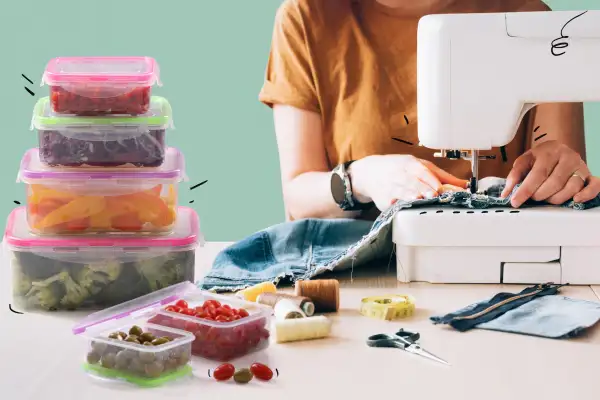How to Make Everything You Buy Last Longer

For most people, buying items built to last a lifetime feels increasingly out of reach.
Fast-fashion giants like Shein, Zara and H&M have taken over the clothing market, providing an endless stream of $20 winter coats and $5 bathing suits to online shoppers. Quality, long-lasting furniture isn’t as prevalent on Facebook Marketplace as it once was, and even the most basic Ikea couch now runs upwards of $700. And while the blenders, microwaves and refrigerators in the average American kitchen are more energy efficient than ever, when these appliances break, they’re hard, if not impossible, to repair.
Rising prices have made the once-popular mantra of “buy once, cry once” all but obsolete, as more people buying everyday items are forced to opt for the cheapest option available. (Why would you spend half your paycheck on a Vitamix, after all, when you can buy a Temu knockoff for 30 bucks?)
It’s a vicious cycle that drains our time, demands endless research and empties our wallets. But the solution is within reach.
The fact is, there’s a lot we can do to preserve and repair the stuff we already own — from our jeans to our leafy greens.
Here’s how.
Learn some laundry skills
Modern washing habits are incredibly hard on clothes, and can significantly shorten their lifespan. Clothes dryers, for one, cause synthetic fabrics like nylon, polyester and elastane — materials that take up an increasing share of our wardrobe — to melt and degrade when subjected to heat. If you've ever purchased a pair of jeans that became wrinkly and saggy after just a few wears, the elastane in the denim and the hot dryer you threw it into are likely to blame.
Washing machines aren't particularly gentle on fabric, either, especially if you own a top-loading machine. The good news is, just a few small changes will go a long way toward preserving your clothes.
First things first: If you have the space, start air drying on an outdoor clothesline. If you don’t, grab a $30 drying rack from a big box store (or a $10 renter-friendly retractable clothesline online) and use that instead.
If you use a top-loading washing machine, use a mesh laundry bag to protect delicate and stretchy fabrics from the center agitator inside. And no matter what type of machine you have, it's best to steer clear of fabric softener, which builds up on, and eventually deteriorates, clothes and other textiles. (Towels, for instance, become waxy and less absorbent over time.)
“The easiest way to extend the life of your clothing is to consider how you wash it,” says Katrina Rodabaugh, author of “Mending Matters: Stitch, Patch, and Repair Your Favorite Denim & More”. “Washing on cool water, [using] full loads, and air-drying will prevent unnecessary aging.”
Clothing experts recommend a few other techniques to extend the lifespan of your garments. For starters, don't throw out your white clothes if they start to develop that dreaded yellow hue. With a bit of color theory magic, you can return the fabric to its original glory with bluing liquid, a concentrated dye that’s been helping homemakers neutralize yellow-toned fabrics since the 1800s. All you have to do is dilute a few drops in a cup of water and pour the solution into your washer during a rinse cycle.
You should also learn how to treat stains properly, says Derek Guy, author of the Die Workwear! blog. An oil-based stain from salad dressing or pizza might require a stronger detergent and a longer soak time compared to a water-based stain like orange juice or sweat.
Water temperature also matters. Hot water can help remove oil or grease stains but protein-based stains from things like egg yolks, dairy, or blood shouldn't be soaked in hot water — this will literally cook the stain into the fabric.
Generally speaking, your best bet is to read the care labels on your clothes before you toss them in the wash. If you can wash the garment at home, do so with lukewarm water and the gentlest detergent you have on hand, moving on to a stronger product if necessary. If the tag says “dry clean only,” think about how much use can get out of the garment. Paying for a professional, high-end dry cleaner doesn't make sense for every garment — a $20 T-shirt is probably not worth the hassle, but a beloved winter coat might be.
“If it holds sentimental value, if it's expensive, if you absolutely cannot risk getting it damaged, then send it to a professional,” Guy says.
Be sure to store your clothes properly, too. If you live in a place with cold winters, and own a lot of wool garments as a result, Guy recommends staving off moths by wrapping wool clothes in a clean sheet made of 100% cotton and sealing them in a plastic tub when the season ends. Insects that eat wool fibers typically don't eat cotton fibers, he explains.
More resources
- "Home Comforts: The Art and Science of Keeping a Home" by Cheryl Mendelson has over 300 pages dedicated to fabric maintenance alone.
- "The Laundry Book: The Definitive Guide to Caring for Your Clothes and Linens" by Zak and Jerry Pozniac is an accessible guide written by third- and fourth-generation dry cleaners.
- "How to wash your whites and keep them super bright" by Rajiv Surendra is an in-depth tutorial on keeping white fabrics as good as new.
Master the mend
Mending your own clothes can be intimidating, especially if you’ve never so much as stitched a loose button onto a pair of old jeans. But there are lots of beginner-friendly techniques that, with just a little practice, can save your clothes from the landfill.
A good way to start mending is by identifying any weak seams in your clothes and making a few reinforcement stitches. All you need is a needle and thread (and maybe a thimble, if you feel clumsy).
Patching is another great entryway into mending. Ideally, the patch should be of the same thickness, weight and material as the original garment. A mid weight woven fabric like denim, which Rodabaugh calls a “utilitarian fiber,” is great for beginners, she says.
You can take it a step further and try “visible mending,” a growing trend where menders of all skill levels make intentionally visible stitches — turning the repair into part of the garment's design. Visible mending can involve elaborate embroidery, or just a simple patch that covers a flaw with a piece of contrasting fabric.
More resources
- "Mending Matters: Stitch, Patch, and Repair Your Favorite Denim & More" by Katrina Rodabaugh
- Evelyn Wood's Mending Clothes playlist, a compilation of mending video tutorials catered to beginners
- Suay, a Los Angeles-based company, runs a mail-in "community die bath" dedicated to giving old garments new life.
- Tanner Frost Bowen, textile artist and founder of the sustainable sewing platform Garbie.
- Tatter, a non-profit exploring the cultural and historical value of textiles, has an event calendar filled with virtual embroidery workshops.
- The Endery, a knitwear brand, runs an online mending hub with classes and tutorials.
Maximum food, minimum waste
Our great-great grandparents preserved their food by salt-curing, canning, fermentation and sand burials (Weird fact: an unwashed carrot can stay fresh for months if you bury it in sand). Now, we rely on an unassuming but revolutionary appliance: the refrigerator.
Designed to keep food at 40 degrees Fahrenheit or lower, the fridge does most of the preserving for us, but you can extend the life of your groceries with a few simple hacks. First, make sure your fridge is running at the recommended 32 to 40 degrees and your freezer is set to 0 degrees or lower. Grab a couple fridge/freezer thermometers from your local hardware store to keep in each unit — they’ll let you know if something is off.
When storing fresh fruits and vegetables, wash them only if you're going to use them within the next two days. If not, it's best to store them in the refrigerator unwashed, since moisture accelerates wilt and rot.
Here are some other ways to step up your food storage game:
- Store delicate leafy vegetables in a clear container or plastic bag along with a few sheets of paper towels. The towel will prevent wilting by absorbing excess moisture, and the clear container ensures you won't lose sight of the ingredients. (Bonus points if you label the container with the date of purchase).
- Place cotton towels at the bottom of your fridge's crisper drawer and put your produce on top. The towels will absorb excess moisture and make clean-up a breeze.
- Invest in a vacuum sealer and repackage your food prep in an air-tight bag. This will protect it from most factors that accelerate spoilage. Alternatively, check out the YouTube video by Kenji López-Alt, chef and author of “The Food Lab,” on how to create an airtight seal using a ziplock bag and a tub of water.
When the inevitable happens — i.e, your food spoils — save your scraps for compost. If you have enough outside space — and/or a garden hungry for nutrients — go the DIY route and compost food waste yourself. Otherwise, read up on the community composting programs in your area, and how to get involved.
Protect your most vulnerable items
Out of everything you own, your couch, mattress and carpet typically see the most wear and tear. And though we’ve been trained to think that expensive designer furniture will outlast budget pieces, the reality is a bit more nuanced.
The fact is, the longevity of home furnishings isn’t always dependent on the design or the price tag, but how it’s maintained. A budget-brand couch that's well-kept and protected can outlast an expensive one that takes a beating on the regular. And no matter how much money you’ve spent on furnishing your house, your best bet to make these high-traffic pieces last longer is to focus on protection.
Carpet
To protect carpeted flooring, consider spraying it with a soil-repellent finish. This treatment repels water and oil and keeps dirt and other contaminants from penetrating the fabric quickly. In theory, this should give you enough time to clean up a spill before it seeps into the material. The caveat? If the stain manages to set on the carpet, it'll be much harder to remove.
Mattresses
Mattress maintenance is pretty straightforward. Rotate it 180 degrees (i.e., switch the position of the head and foot of the bed) every three to six months and put a waterproof protector on it. Gone are the days of plasticky mattress protectors: There are plenty of comfortable, fabric-like options on the market today that mimic the feel of soft sheets and still do a good job of safeguarding your mattress from spills, dust and dirt.
If it feels like your mattress is near the end of its life, try putting a latex or memory foam mattress topper on it. These typically cost a fraction of the price of a new mattress and, depending on the quality of the topper, can extend the life of your current mattress by several more years.
Upholstered furniture
The lifespan of couch upholstery depends on the material. For instance, couches upholstered with synthetic fibers like polyester and microfiber resist stains, snags, and fading better than natural materials like linen or cotton. And if you're starting to feel the couch sagging, fixing it could be as simple as rotating the cushions.
An easy way to protect a couch or sofa is by putting a protective cover made out of a durable material like microfiber. Alternatively, you can use an old fitted sheet and put it over the couch when it's not in use. It might not be the most aesthetically pleasing solution but it'll do the job, especially if you have small children or pets around the home.
Like every other item on this list, today’s home furnishings market is choked by subpar quality and rising price tags. Protecting and preserving what you already own isn’t just resourceful — it builds resiliency and community.
More From Money
10 Everyday Items Trump's Tariffs Could Make Pricier
Worried About a Recession? Make These 8 Money Moves Now
From Costco Chicken to Whiskey: Prices for These 6 Items Have Somehow Survived Inflation


